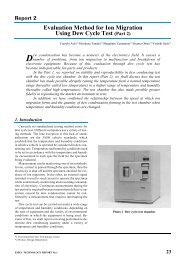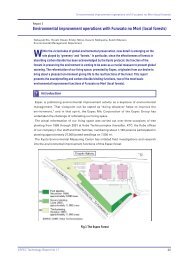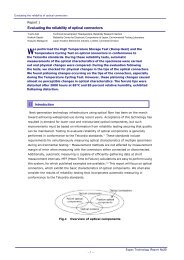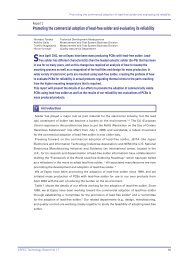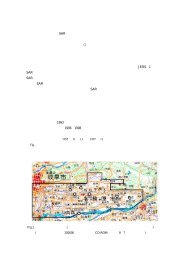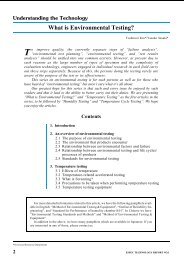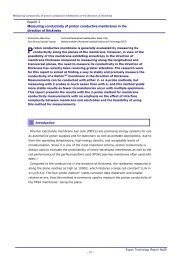Download
Download
Download
You also want an ePaper? Increase the reach of your titles
YUMPU automatically turns print PDFs into web optimized ePapers that Google loves.
5-4-2 EIAJ (Electronic Industries Association of<br />
Japan, currently Japan Electronics and<br />
Information Technology Industries<br />
Association)<br />
The creation of the Japan Electronics and Information<br />
Technology Industries Association (JEITA) in November<br />
2000 resulted from a merger of the Japan Electronic<br />
Industry Development Association and the Electronic<br />
Industries Association of Japan. Existing standards from<br />
the old organizations were transferred unchanged to the<br />
new organization. In other words, standards from the<br />
Electronic Industries Association of Japan, known as<br />
“EIAJ standards,” continue to exist and are still called<br />
“EIAJ standards.” Standards are issued for each<br />
individual environmental test. Table 10 presents some<br />
examples of EIAJ environmental testing standards.<br />
Table 10 EIAJ standards for environmental test<br />
methods<br />
No. Title<br />
CP-5102 Methods of measurement on receiving antennas<br />
for SHF satellite broadcast transmission<br />
(mechanical and environmental characteristics)<br />
ED-2531 Environmental test methods for Liquid Crystal<br />
Display devices<br />
ED-4701* Environmental and endurance test methods for<br />
semiconductor devices<br />
ED-8403 Environmental and endurance test methods for<br />
semiconductor pressure sensors (diffused<br />
piezoresistance type)<br />
ED-8503 Environmental and endurance test methods for<br />
mini-mold type hall sensors<br />
ET-7407* Environmental and endurance test methods for<br />
CSP/BGA package on mounting condition<br />
RC-8325 Testing methods for environmental test of audio<br />
magnetic heads<br />
* English versions have been issued for standards marked with<br />
an asterisk.<br />
5-4-3 JTM (Testing Machinery Association of Japan)<br />
The standards issued by the Testing Machinery<br />
Association of Japan differ from those we have been<br />
discussing up to this point. Rather than addressing<br />
environmental test methods, these standards are set for the<br />
test equipment. Tabai is a member of this association, and<br />
participates in issuing the standards. Table 11 presents<br />
some examples of JTM standards.<br />
No. Title<br />
JTM K-01:1998 Humidity chambers—Test and indication<br />
method for performance<br />
JTM K-02-1999 Standard for safety of humidity chambers<br />
JTM K-03-1992 Standard for performance of environmental<br />
temperature and humidity rooms<br />
JTM K-04:1992 Standard for safety of environmental<br />
temperature and humidity rooms<br />
JTM K-05:2000 High temperature chambers—Test and<br />
indication method for performance<br />
JTM K-06: 2001 Standard for safety of high temperature<br />
chambers<br />
6. Supplement<br />
Table 11 JTM standard<br />
This report has presented a brief overview of<br />
environmental testing standards to provide an aid to<br />
understanding the basics of those standards. While the<br />
examples given are typical, they cannot provide a<br />
thorough treatment of the subject. Please realize also that<br />
the test methods presented in the tables cannot cover<br />
every aspect.<br />
As has been noted, obtaining information about<br />
standards requires knowledge of trends in test technology,<br />
and so one must be vigilant in keeping up with the latest<br />
trends.<br />
ESPEC TECHNOLOGY REPORT No. 12 9



